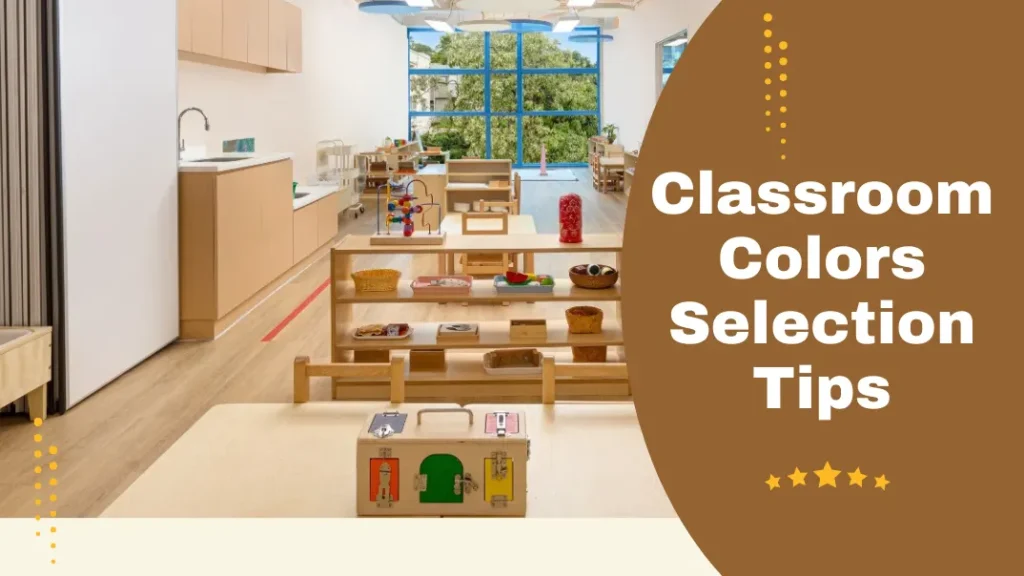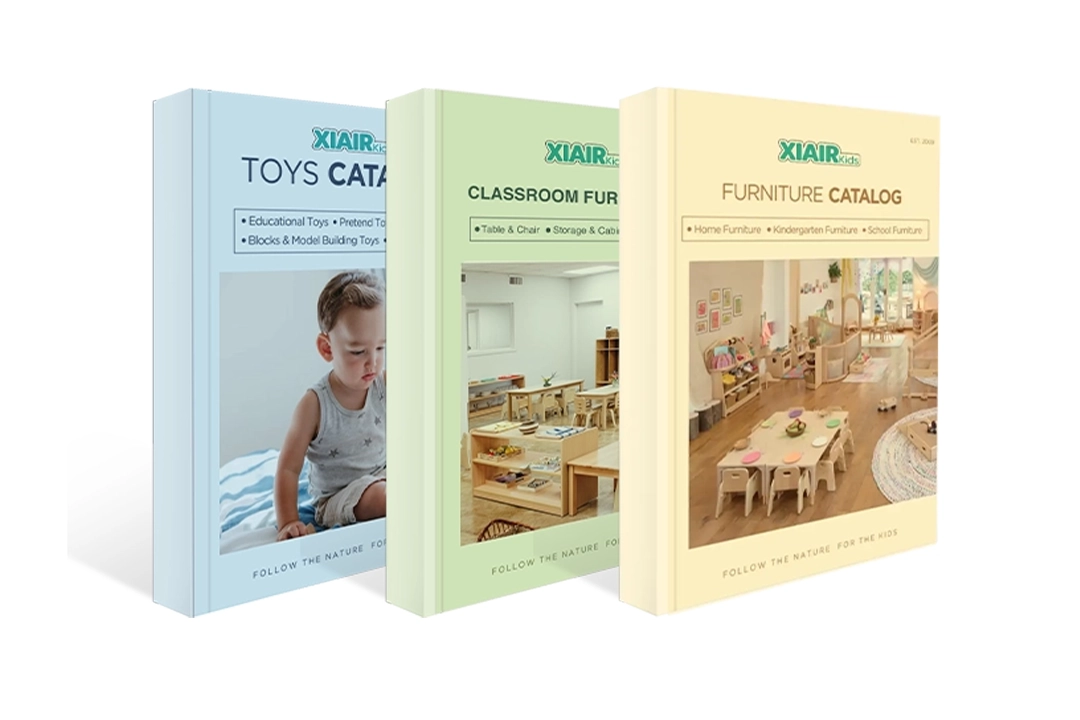Choisir les bonnes couleurs pour une salle de classe peut être complexe. Face à la multitude d'options et de facteurs, on peut facilement se sentir perdu. Pourtant, les couleurs choisies peuvent avoir un impact profond sur l'humeur, l'attention et les capacités d'apprentissage des élèves. Comment garantir que vos choix de couleurs favorisent un environnement d'apprentissage productif, stimulant et agréable ?
Les couleurs en classe ne se limitent pas à des choix esthétiques : elles influencent les émotions, la concentration et le comportement général des élèves. En comprenant l'impact des différentes couleurs, les enseignants peuvent créer des environnements propices à l'apprentissage, stimulant la créativité et favorisant le bien-être émotionnel. Choisir les bonnes couleurs pour votre classe créera un environnement d'apprentissage plus efficace et harmonieux.
Nous aborderons l'importance des couleurs, les facteurs à prendre en compte lors du choix et les couleurs les plus adaptées à l'apprentissage. Que vous conceviez une nouvelle salle de classe ou rénoviez une salle existante, ce guide vous aidera à choisir la palette idéale.
Importance des couleurs en classe
Les couleurs dans une salle de classe vont au-delà de la décoration. Elles peuvent influencer le comportement, la concentration, les émotions et les résultats d'apprentissage des élèves. Des recherches montrent que différentes couleurs influencent la concentration, la créativité et l'humeur générale. Par exemple, les tons bleu et vert sont largement reconnus comme des couleurs apaisantes qui favorisent la concentration, tandis que les teintes chaudes comme l'orange et le jaune apportent énergie et créativité.

Une salle de classe colorée, visuellement attrayante sans être trop stimulante, peut améliorer le bien-être et les performances des élèves. Si la palette de couleurs d'une salle de classe favorise la détente et l'engagement des élèves, ils seront plus enclins à se concentrer sur leurs tâches et à interagir positivement. À l'inverse, l'utilisation de couleurs trop sombres ou intenses peut augmenter le stress et réduire la productivité.
Créez des espaces propices à l'apprentissage, à l'épanouissement et au bien-être émotionnel grâce à des thèmes de couleurs adaptés à votre classe. décorations de classe rend la pièce accueillante et ajoute de la chaleur, aidant les étudiants à se sentir à l'aise et impliqués.
Facteurs à prendre en compte lors du choix des couleurs de la salle de classe
Choisir les meilleures palettes de couleurs pour une salle de classe ne se limite pas à choisir des nuances dans un nuancier. Il est essentiel de prendre en compte l'environnement de la classe, son utilisation prévue et les besoins spécifiques des élèves. Voici les facteurs clés à prendre en compte :
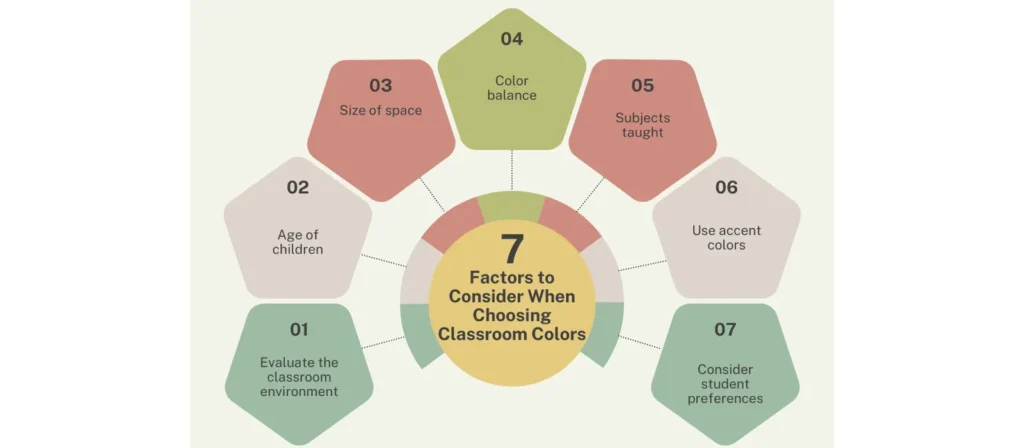
1. Évaluer l'environnement de la classe
Tenez compte de l'environnement physique lors du choix des couleurs de la salle de classe. La salle bénéficie-t-elle de beaucoup de lumière naturelle ? Est-elle petite ou grande ? Existe-t-il déjà une palette de couleurs spécifique ? Les réponses à ces questions vous aideront à choisir les palettes de couleurs les mieux adaptées à l'espace. Par exemple, les salles de classe peu éclairées peuvent bénéficier de couleurs vives comme des jaunes ou des blancs doux, rendant l'espace plus ouvert et accueillant.
2. Âge des enfants
La tranche d'âge que vous enseignez joue un rôle important dans le choix des couleurs. Les plus jeunes élèves bénéficient souvent d'une classe aux couleurs primaires, vibrantes et éclatantes, qui stimule la curiosité et l'énergie. En revanche, les élèves plus âgés s'épanouissent dans des couleurs apaisantes qui favorisent la concentration, comme les bleus et les verts doux. Un thème de classe coloré est idéal pour les classes de maternelle, où des décorations lumineuses et colorées stimulent et inspirent les enfants.
3. Taille de l'espace
La taille de la salle influence la perception des couleurs. Les grandes salles de classe peuvent accueillir des couleurs vives sur les murs ou une décoration colorée, comme de grandes affiches ou des éléments décoratifs. Les petites salles de classe bénéficient de tons plus doux et subtils, comme des couleurs pastel apaisantes, qui contribuent à créer une impression d'espace moins exigu.
Ne vous contentez pas de rêver, concevez-le ! Discutons de vos besoins en mobilier sur mesure !
4. Équilibre des couleurs
L'équilibre est essentiel lors de la conception des combinaisons de couleurs en classe. Trop de tons vifs peuvent surstimuler les élèves, tandis que trop de tons neutres peuvent ternir l'espace. Un équilibre judicieux : utiliser couleur neutre La décoration de la salle de classe comme base, accentuée par des tons plus clairs, crée un espace visuellement attrayant qui ne submerge pas les élèves.
5. Matières enseignées
Certaines matières se prêtent naturellement à des couleurs spécifiques pour l'apprentissage. Par exemple, les cours d'arts plastiques peuvent bénéficier de couleurs vives et dynamiques qui stimulent la créativité. À l'inverse, les cours de mathématiques ou de sciences peuvent privilégier des couleurs apaisantes comme le vert ou le bleu pour favoriser la concentration et la pensée logique.
6. Utilisez des couleurs d'accentuation
Les couleurs d'accent peuvent contribuer à définir différents espaces de la classe, comme un coin lecture ou un espace de travail en groupe. L'utilisation stratégique de couleurs vives comme l'orange et le jaune permet de mettre en valeur certaines zones.
7. Tenez compte des préférences des étudiants
Les préférences des élèves comptent également. Certains peuvent avoir des préférences ou des aversions marquées pour certaines couleurs. En tenir compte lors du choix des couleurs de la classe peut contribuer à créer un espace où les élèves se sentent à l'aise et impliqués.
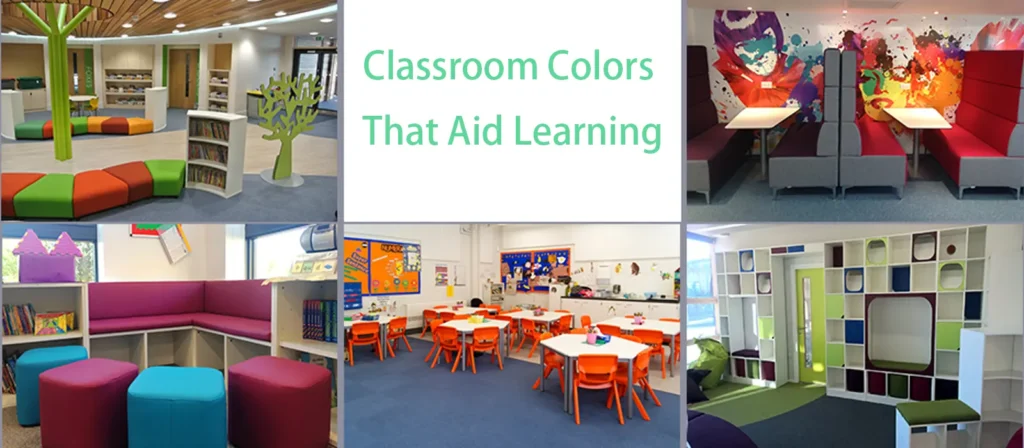
Couleurs de classe qui facilitent l'apprentissage
Différentes couleurs peuvent avoir des effets psychologiques spécifiques, rendant certaines nuances plus adaptées que d'autres aux palettes de couleurs des salles de classe. Voici quelques couleurs couramment utilisées dans les salles de classe colorées et leur contribution à l'apprentissage :
- Orange
L'orange est une couleur vibrante et énergisante, idéale pour favoriser les interactions sociales et la créativité. Elle est parfaite pour les espaces où activités de groupe Cependant, utilisez-le avec parcimonie, car trop d'orange peut être écrasant.
- Vert
Le vert est apaisant et favorise la concentration. C'est l'une des couleurs les plus adaptées à l'apprentissage en classe, car il réduit le stress et est doux pour les yeux, ce qui en fait un choix idéal pour les espaces d'étude.
- Rouge
Le rouge attire l'attention et stimule la vigilance. Bien qu'une trop grande quantité de rouge puisse être perturbante, il peut être utilisé efficacement comme couleur d'accent pour encourager la vigilance dans les espaces d'apprentissage actif.
- Bleu
Le bleu favorise le calme et améliore la concentration, ce qui en fait l'une des couleurs idéales pour les salles de classe où la concentration est essentielle. Son effet apaisant en fait un outil idéal pour réduire le stress.
Quelles sont les couleurs apaisantes en classe ?
Les couleurs apaisantes en classe sont idéales pour les espaces où les élèves ont besoin de se détendre et de se concentrer, comme les coins lecture ou les zones de calme. Voici quelques-unes des couleurs apaisantes les plus efficaces :
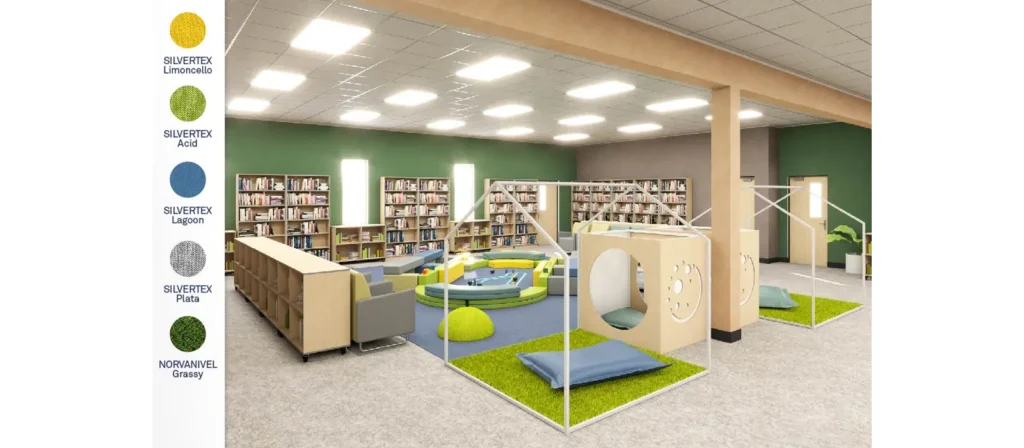
- Bleu doux:Connu pour ses effets apaisants, il aide les étudiants à se sentir calmes et réduit l’anxiété.
- Lavande:Les tons violet clair créent une atmosphère tranquille et stimulent la créativité.
- Vert clair:Le vert a un effet d'ancrage, ce qui est idéal pour les zones où la concentration est nécessaire.
- Beige:Un neutre chaleureux qui offre un arrière-plan paisible et caché.
- Pastels:Le thème de la classe aux couleurs pastel fonctionne bien pour créer un environnement lumineux, aéré et apaisant.
L'impact des couleurs en classe
Voici comment les différentes couleurs de classe ont un impact psychologique sur les élèves et à quelles zones de la classe elles conviennent le mieux :
| Couleur | Impact psychologique | Meilleure utilisation |
|---|---|---|
| Bleu | Apaisant, favorise la concentration et la focalisation | De longues séances d'étude, réduisant le stress |
| Vert | Équilibre et apaise, idéal pour une concentration soutenue | Sciences, espaces de lecture, espaces d'apprentissage calmes |
| Jaune | Zones d'activités, de sports ou d'interactions | Espaces d'art ou de brainstorming |
| Rouge | Propre et neutre, il aide à la clarté et à la concentration | L'énergie stimule la motivation |
| Orange | Chaleureux et accueillant, encourage l'interaction sociale | Activités de groupe, espaces de travail collaboratifs |
| Blanc | L'inspiration favorise la créativité et l'imagination | Murs généraux de classe, espaces flexibles |
| Violet | Inspirant, favorise la créativité et l'imagination | Salles de classe d'art ou de design |
| Brun | Ancrant et réconfortant, idéal pour la stabilité | Coins bibliothèque, coins lecture |
Couleurs des meubles de classe
Les couleurs du mobilier scolaire sont essentielles pour créer un environnement d'apprentissage stimulant et confortable. Voici quelques choix populaires :
- Meubles neutres: Une décoration et un mobilier de classe aux couleurs neutres contribuent à équilibrer la pièce, permettant aux couleurs vives des murs ou des décorations de ressortir. Les tons blancs, beiges ou gris créent une ambiance calme et ordonnée.
- Bacs colorés pour la salle de classeUtiliser des bacs colorés pour le rangement en classe ajoute une touche ludique et pratique pour organiser les élèves. Les bacs aux couleurs vives sont non seulement pratiques, mais apportent également de la couleur sans surcharger l'espace.
- Meubles aux couleurs vivesUn mobilier clair apporte du dynamisme, notamment dans les classes de jeunes élèves. Des chaises ou des tables colorées peuvent dynamiser les élèves, mais doivent être contrebalancées par des murs neutres pour éviter toute surstimulation.
- Meubles en bois:Les tons de bois naturels procurent une sensation chaleureuse et réconfortante. Mobilier de classe en bois est polyvalent et convient aux thèmes de classe aux couleurs pastel et aux conceptions de couleurs de classe plus audacieuses.
Votre salle de classe idéale est à un clic !
Les trois meilleures couleurs pour les salles de classe
Bien qu’il n’existe pas de réponse universelle, ces trois couleurs sont largement considérées comme faisant partie des meilleures couleurs pour la salle de classe :
- Bleu:Favorise la concentration et le calme, ce qui le rend idéal pour les zones où les étudiants ont besoin de se concentrer.
- Vert: Offre un effet équilibré et apaisant, parfait pour les zones d'étude et les thèmes de couleurs apaisants en classe.
- Jaune: Stimule la créativité et l’optimisme, excellent pour le travail de groupe et les zones où l’interaction est encouragée.
En utilisant ces combinaisons de couleurs de classe et en les équilibrant avec des tons d'accent, vous pouvez créer un thème de classe coloré qui répond aux besoins émotionnels et cognitifs des élèves.
Conclusion
En conclusion, les couleurs en classe ont un impact significatif sur le comportement, les émotions et l'apprentissage des élèves. Les enseignants peuvent créer des environnements qui favorisent la concentration, la créativité et les interactions sociales positives en comprenant les effets des différentes couleurs et en les utilisant judicieusement dans une palette de couleurs cohérente. Une conception des couleurs adaptée à la classe ne se limite pas à l'esthétique, favorisant le bien-être des élèves et les aidant à atteindre leur plein potentiel.
